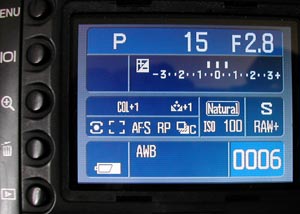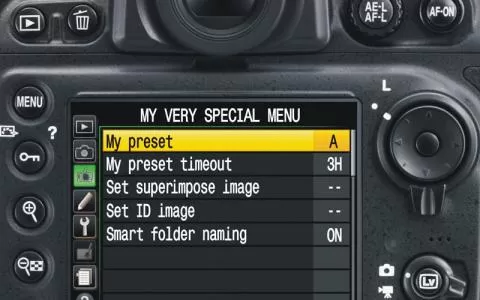Why Minolta's way of using the large display on the backside of their DSLR's is such a brillant idea
Ever since I first bought my Minolta Dynax 7 for film, I have found that the way Minolta uses the large display on the backside of the camera to be the only right way of doing things. And I have wondered why none of the other manufacturers do the same thing.
People who have never shot with one of the Minolta 7, 7D or 5D may have no idea what I'm talking about, so let me explain.
The Dynax 7 for film was the first ever SLR to feature a large LCD-display on the back of the camera. There were date backplates and similar gadgets, which had displays, but this camera came right out of the box with a large display on the film compartment lid. This display shows a large variety of things. Of course it displays the whole menu system while you're using that, but the real strike of genious is to let the display show exposure information. Most SLR's have small displays on the top of the camera, where you can see aperture, exposure etc. But on the Dynax 7, the back LCD shows all this, and in great detail. The display can show a variety of different views and even rotates when you rotate the camera.
"Well, big news!" you might say. "Even the smallest digital camera has that feature...".
Yep, that's true enough, but none of the SLR's have. They use the display for reviewing pictures and showing menus only, and not for displaying exposure information while you're shooting.
Bitmapped or not
A bitmapped display is a display where any pixel can be controlled individually. A computer screen is bitmapped. Modern color LCD-displays on the back of any digital camera are bitmapped. They can show any picture you want, menus, histograms and a host of other things.
A B/W LCD-display as they are seen on many cameras is not bitmapped. It's hardcoded to turn on and off in specific areas, and all numbers, symbols and graphics are predefined, and can only be shown or not shown.
A bitmapped display can be programmed to show anything. The B/W LCD can not. You have probably noticed that sometimes you can see light grey "ghosts" of symbols and text on B/W displays when you tip them a bit. These are the turned-off elements of the display and reveal the things that the display can show.
The advantage
On the Minolta DSLR's, namely the 7D and the 5D (and the upcoming Sony Alpha), the large display on the backside shows the exposure information in great detail. And it rotates when you turn the camera. This might not seem like a big deal to most Nikon and Canon SLR users -- some even complain about the lack of a display on the top of the Minolta cameras -- but let me explain why the use of this display is such a brillant idea.
First of all the LCD on the backside is larger and contains more detail about everything. The Minolta-cameras even offer several settings with different detail levels.
Secondly it's much more in eye level there. I use this display a lot when I fiddle the exposure settings, and it seems more logical to me to just have to lift the camera away from my eyes to see only slightly more information than I find in the veiwfinder. And on a tripod this information is just where I want it.
A third thing is the versatility of this display. Since it's bitmapped rather than hard-coded (see side box), so I can show different text- and number-sizes, different graphical details and different sections of information.
On and off
The display turns on when you turn on the camera. It's bright and easy to see, but actually too bright to be lit when you have you eye on the viewfinder. This has been solved by letting the camera turn off the display when it's close to your face. Two sensors "see" things approaching and turn off the diplay, when anything is close enough. In the same way they turn the display back on as soon as you remove the camera from your eyes.
The display can of course be turned completely off, in which case you just use the information in the viewfinder.








